Hearing aids are available in different types and styles including analog, digital, rechargeable aids. The functionality, sound and clarity can also be very different depending on the type. The cost usually depends on the technology level and benefits to the user and not the style of hearing aid. Hearing aids today start at the basic level up to the premium level and the price changes as the level changes.
The clearest speech understanding is achieved with the premium level of aid which can also automatically make changes based on the listening environment. As comparison, rudimentary speech understanding is achieved with basic level aids and most adjustments are made by the user including volume changes, bass and treble, and program changes. There is a clear difference in clarity based on the level of aid, but the same technology can be provided in many of the styles (i.e. RIC, BTE, etc).
Consider the following when selecting a style:
- Use of your hands
- Hearing loss level
- Environments when you wear the aids
- Your finances
- Suggestion by your Hearing Instrument Specialist
- Biologic issues with the ear canal
Styles Of Hearing Aids
Hearing aids are available in many different sizes and styles thanks to advancements in digital technology and miniaturization of the internal components. Many of today’s hearing aids are considered sleek, compact and innovative – offering solutions to a wide range of hearing aid wearers.
Depending on your personal preferences and hearing needs, our hearing aids come in a wide variety of styles. The best hearing aids for you will be based solely on your hearing range, determined by your hearing test. Click on a style below to learn more.
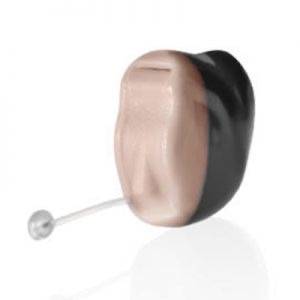
INVISIBLE IN THE CANAL (IIC)
Smallest Hearing Aid with The Highest Quality Sound
Invisible-In-Canal (IIC) hearing aids are the first 100% invisible hearing instruments on the market. Each of these Invisible Hearing Aids are custom fit to your ears. They can be placed past the second bend in your ear canal. Making them virtually undetectable. Due to deep placement, Invisible Hearing Aids benefit from the natural acoustics of the ear. Sound travels quickly and accurately to your eardrum. It is designed for daily removal.
And though tiny, invisible hearing aids come loaded with all the leading technology. Invisible hearing instruments come in both wireless and non-wireless option. Wireless connectivity means you can receive a direct wireless connection with your cell phone. Wireless accessories can also be used with premier invisible hearing aids, giving you the ability to stream TV, music and much more.
Invisible Hearing Instruments give you the highest quality sound while being the most discreet. Invisible hearing aids have multi-memories that can be changed using T2 technology. Giving you the control to adapt the sound of your hearing aids to the listening environments around you.
If you have a mild to moderately severe hearing loss invisible hearing aid could be your answer. Hear all the sounds without anyone being aware that you are wearing a hearing device.
Invisible In Canal (IIC)
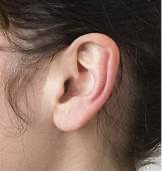
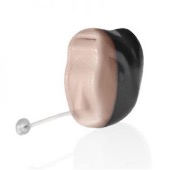
IIC hearing aids are the smallest hearing aids and are not visible from someone looking from the side. Due to their size, they are only suitable for people with mild to moderate levels of hearing loss. They use the smallest battery for hearing aids which needs to be replaced twice a week.
Completely In Canal (CIC) Hearing Aid
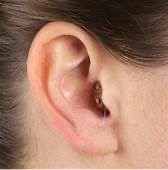

CIC hearing aids are the second smallest hearing aids, are slightly visible, but fit snug into the ear canal. They also are only suitable for people with mild to moderate levels of loss but are sometimes chosen for cosmetic reasons. They use the smallest battery for hearing aids which needs to be replaced twice a week.
In The Canal (ITC) Hearing Aid


ITC hearing aids are the third smallest hearing aids, are also called half shell hearing aids, and fit in the outer ear bowl as opposed to buried in the canal.
They use a larger battery than IIC and CIC hearing aids so the battery needs to be replaced about once per week. They also are available in rechargeable styles. Having a larger faceplate allows then to have two microphones on each hearing aid which enables better speech understanding in noisy environments. ITC aids also are suitable for people with mild to moderate levels of loss.
In The Ear (ITE) Full Shell

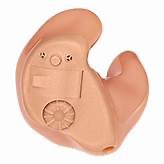
ITE hearing aids fit flush with the entire concha (bowl) of the ear, are also called full shell hearing aids, and fit in the outer ear bowl as opposed to buried in the canal. They are available in two different sized disposable batteries which need to be replaced every 7-12 days. They are also available in rechargeable models. Having a larger faceplate allows then to have two microphones on each hearing aid which enables better speech understanding in noisy environments. ITE aids also are suitable for people with a moderate to severe hearing loss.
(RIC) Receiver In Ear Hearing Aid
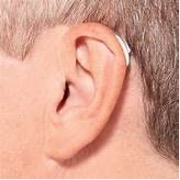
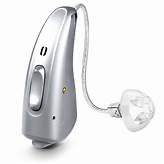
RIC hearing aids fit behind the ear and the speaker of the aids are inserted into the ear canal with a silicone rubber tip. They are suitable for people with a mild to severe hearing loss. They are available in disposable batteries which need to be replaced every week. They also have rechargeable models.
Mini (RIC) Receiver In Ear Hearing Aid
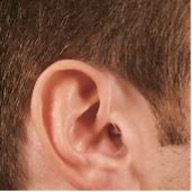
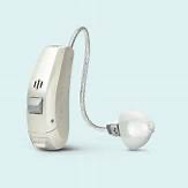
Mini RIC hearing aids fit behind the ear and the speaker of the aids are inserted into the ear canal with a silicone rubber tip. They are suitable for people with a mild to moderate hearing loss. They are smaller than a traditional RIC aids and have less features and power. They are only available in the smallest disposable batteries which need to be changed every 3-4 days and they also have rechargeable models.
Behind The Ear (BTE) Hearing Aid
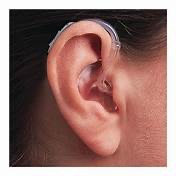
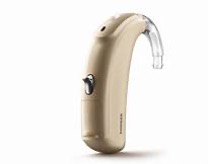
(BTE) Behind the Ear hearing aids fit behind the ear and uses tubing into the ear to connect to a silicon rubber tip, a rubber mold, or a plastic mold. Due to their size and power, BTE aids are typically suitable for people with severe to profound hearing loss. They have all the features of RIC aids, but with more power for those with more hearing loss. They are available in disposable batteries which need to be changed every 7-10 days and they also have rechargeable models.
